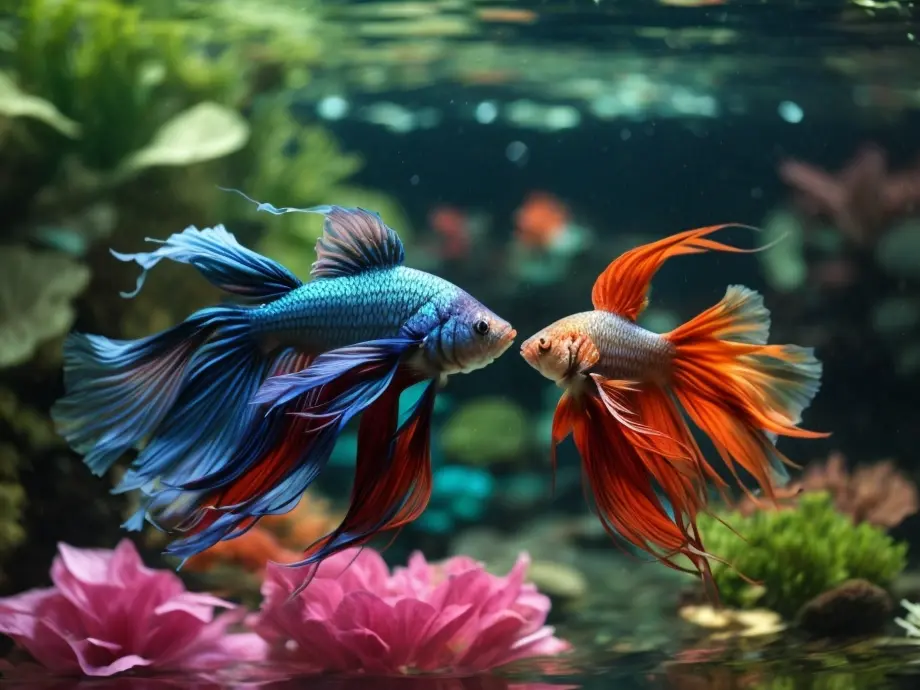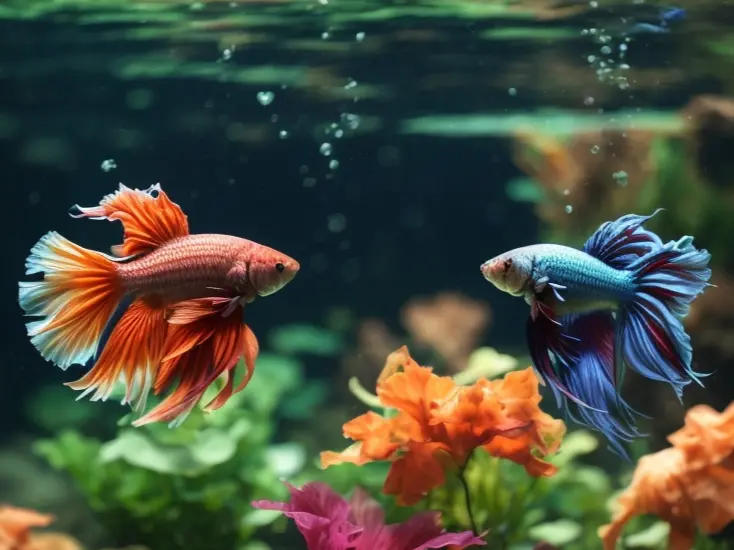The compatibility between betta fish and shrimp is a hotly debated topic in the aquarium hobby. While some betta fish can coexist peacefully with shrimp, others may see them as prey and attack. Before adding shrimp to a betta tank, there are many factors to consider, and proper precautions must be taken to give both species the best chance of thriving.
This comprehensive guide will examine whether bettas eat shrimp, which shrimp species fare better with bettas, tank requirements, introducing shrimp to a betta tank, dietary considerations, and safety measures. With the right approach, it is possible to keep a community of bettas and shrimp successfully. Read on for an in-depth look at this nuanced issue.

Basics of Keeping Shrimp with Betta Fish
Before delving into the specifics, it is important to understand the basic care requirements for keeping shrimp and betta fish together.
Similar Water Parameters
Luckily, betta fish and most freshwater shrimp thrive under similar water conditions. Both require soft, slightly acidic water with the following parameters:
- Temperature between 74-82°F (20-24°C)
- pH between 6.5-7.5
- KH between 3-5° dKH
- GH between 5-10° dGH
Providing water parameters in this range will help ensure the health and comfort of both species.
Sufficient Tank Size
Betta fish should be kept in at least 5 gallons of water, while shrimp need a minimum of 10 gallons to thrive. A 10-20 gallon planted tank is ideal for a small shrimp community and a single betta. This provides adequate territory for both and allows the shrimp to find shelter.
Places to Hide
Shrimp feel safest when they have plenty of hiding spots. Include thickets of moss, floating plants like hornwort, rocks, driftwood, and decorations with crevices. These will allow shrimp to duck out of sight when feeling threatened.
Key Takeaway
Ensure the tank water parameters, size, and decorations meet the needs of bettas and shrimp before attempting to combine them. This gives both the best chance of cohabitating peacefully.
Types of Shrimp Compatible with Betta Fish
Not all shrimp species are created equal when living with bettas. Some varieties fare better than others due to their size, temperament, and natural camouflage capabilities. Here is how some of the most popular freshwater shrimp match up with bettas:
Amano Shrimp
Native to Japan and one of the most popular aquarium shrimp, Amanos generally do quite well with bettas. Some key reasons include:
- Their large size of 2+ inches makes them less likely to be seen as prey
- Peaceful temperament; unlikely to provoke aggressive behaviors
- Excellent algae eaters help clean the tank
- Transparent bodies and the ability to blend into planted tanks
Amano shrimp and betta fish can make good tank mates with proper precautions.
Cherry Shrimp
Vibrant red Cherry shrimp are extremely popular but tend to be more vulnerable with bettas. Considerations are:
- A much smaller size of 1 inch makes them appear like prey
- Bright red color attracts attention and triggers predatory instincts in bettas
- Very active with quick, darting movements that can incite aggression
- They cannot camouflage easily due to their bright coloration
Cherry shrimp often become snacks for bettas, but success is possible in a heavily planted tank with a non-aggressive betta and supplemental hiding spots.
Ghost Shrimp
Ghost shrimp are a great option with bettas due to their natural camouflage capabilities. Key points are:
- Pale, transparent bodies help them disappear against tank decor
- Grow up to 2 inches, reducing chances of being eaten
- Docile temperament; not likely to annoy bettas
- Can adapt to a variety of tank conditions
Ghost shrimp make one of the best to pair with bettas, although younger or molting individuals may still be at risk.
Key Takeaway
Larger, more peaceful shrimp with natural camouflage, like Amanos and adult Ghost shrimp, are most likely to successfully cohabitate with betta fish. Vibrant, active shrimp like Cherry shrimp often end up as expensive snacks.
Special Cases to Consider
While the above guidelines provide a general overview, it is important to remember that individual betta temperaments can vary. Here are two special cases to keep in mind:
Female Bettas
Although female bettas are generally considered less aggressive than males, they sometimes harass or prey on shrimp. Reasons include:
- More social nature means they may shoal together and hunt prey
- Need to compete for resources due to being housed together
- Smaller mouths can still consume juvenile shrimp
So monitor female bettas carefully and do not assume they will ignore shrimp tank mates.
Marine Bettas
Marine bettas, often sold as “dragon bettas,” differ from freshwater bettas. They should never be housed with freshwater shrimp as they require completely different water parameters including:
- High salinity between 1.020-1.025
- Alkaline pH between 8.1-8.4
- Higher temperatures around 78-82°F
Saltwater conditions would quickly kill freshwater shrimp. Only keep marine bettas with appropriate saltwater tank mates.
Key Takeaway
While species guidelines provide a starting point, individual betta temperament can vary. Monitor all bettas closely when first introducing shrimp. Have backup housing available.
Tank Requirements for Housing Bettas and Shrimp
Providing an adequate tank size and population density is crucial for reducing aggression and competition between bettas and shrimp. Here are some key stocking recommendations:
5 Gallon Betta & Shrimp Tank
A standard 5 gallon is too small for a betta and more than a few shrimp. Possible stocking options include:
- 1 male betta & 5 Amano shrimp
- 1 male betta & 5 adult Ghost shrimp
- Do not attempt to keep Cherry or other small shrimp species
The limited space will make it difficult for the shrimp to get out of the betta’s sight, putting them at high risk of attack.
10 Gallon Betta & Shrimp Tank
A 10 gallon tank provides much more versatility. Some suggested stocking levels:
- 1 betta with 5-10 Ghost or Amano shrimp
- 1 betta with 5-10 Cherry shrimp, provided there are ample hiding spots and plants
- 2-3 female bettas with 10 Ghost shrimp or 5 Amano shrimp
The extra room allows shrimp to find refuge and establish their own territory.
Key Takeaway
When housing bettas and shrimp together, bigger is always better. Aim for at least 10 gallons, and provide plenty of tank decor to break up sight lines and allow the shrimp to hide.
Introducing Shrimp to an Established Betta Tank
Adding new tank mates to an established betta fish’s territory should be done carefully. Use these tips to help the process go smoothly:
Acclimate the Shrimp
Before releasing shrimp into the betta tank, let them acclimate in a separate container for 30-60 minutes. This lets them adjust to the water conditions to avoid shocking their system.
Rearrange Decor Before Adding Shrimp
Bettas are territorial and may view new additions as intruders. Rearrange tank decor, plants, rocks, etc. before introducing shrimp to “reset” the territory.
Dim Lights and Reduce Activity
Keep lights dim and avoid disturbing the tank for the first few hours after adding shrimp. This reduces betta aggression and allows the shrimp to find hiding spots.
Add Shrimp Before the Betta
When possible, introduce shrimp to the tank before the betta. This allows them to scout out hiding places ahead of time, establishing a “home turf” advantage.
Have a Backup Plan
Keep a spare tank or enclosure if the betta does not tolerate the shrimp. Be prepared to remove the betta or shrimp if there are signs of aggression.
Key Takeaway
Take it slow when adding shrimp to an existing betta tank. Have a backup plan if the betta becomes aggressive towards its new tank mates.
Dietary Considerations for Housing Shrimp & Bettas
Providing a proper nutritional diet is important for the health of both betta fish and shrimp. Here are some key dietary considerations:
Juvenile vs Adult Shrimp
Juvenile shrimp under 1 inch are much more likely to be considered food by bettas. Introduce shrimp once they reach adult size for the best chance of survival.
Supplemental Shrimp Food
Offer a quality shrimp pellet or wafer to help ensure the shrimp get adequate nutrition and are less likely to be hunted by the betta.
Dried Shrimp
While dried shrimp can be fed to bettas as an occasional treat, it should not make up the bulk of their diet. Feed a high quality betta pellet instead for balanced nutrition.
Seafood Mixes
Seafood mixes containing shrimp, krill, mussels and more provide variety of bettas but should be used in moderation.
Overfeeding
Feeding shrimp and bettas in a shared tank takes particular care. Only feed what they can consume within 2-3 minutes, 2-3 times daily. Overfeeding causes water fouling and can spike aggressive scavenging behaviors.
Supplements
The addition of supplements like algae wafers, blanched vegetables, and calcium-rich foods can provide nutrients shrimp need but bettas tend to ignore. This helps shrimp thrive without being outcompeted for food.
Key Takeaway
Careful feeding practices are essential in a shared betta and shrimp tank. Prioritize quality foods for each species and avoid overfeeding to prevent aggression over resources.
Safety Measures and Precautions
Even in ideal setups, things can go wrong in a shared tank. Use these precautionary measures to prevent disaster:
Removing Molts
Shrimp are vulnerable right after molting. Quickly remove shed exoskeletons to prevent bettas from picking at live shrimp during this sensitive time.
Monitoring Water Quality
Poor water quality stresses fish and inverts. Stick to a strict water change schedule and immediately address any spikes in ammonia or nitrites.
Emergency Separation
Keep extra enclosures ready for emergency separation. If stressed behaviors occur like fin nipping or rapid breathing, temporarily isolate the betta or shrimp until the issue resolves.
Tank Lids
Secured tank lids are a must. Both betta fish and shrimp can crawl out or jump from tanks, resulting in fatalities if they end up on the floor.
Population Checks
Check on shrimp frequently, especially after molting or new additions. Missing livestock means separating or removing may be needed to prevent further losses.
Key Takeaway
Have emergency protocols in place in case aggression arises or water conditions decline. Vigilance is key for troubleshooting problems between tankmates.

Conclusion
Whether betta fish can live successfully with shrimp does not have a universal answer. With species like Amano and Ghost Shrimp, the chances are quite good. More vulnerable species like Cherry shrimp present more of a challenge.
By following the guidelines of picking suitable species, providing ample space, creatively decorating to break lines of sight, carefully controlling food, and taking emergency precautions, shrimp and betta cohabitation can work beautifully. With good planning and an observant eye, your betta fish can leave your shrimp population alone while enjoying a thriving community tank.
The keys are research, patience, and preparedness for conflict. This guide is a comprehensive resource when exploring the nuances of mixing these popular freshwater fish and invertebrates. With diligence and care, bringing shrimp and bettas together can create an engaging aquascape that brings joy to aquarists and visitors alike.